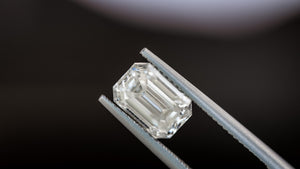The Fours Cs of Diamonds
All diamonds are graded using the Gemological Institute of America (GIA) standard grading scale. This scale was created in the late 1940s by Robert Shipley who founded GIA. The terms used in this grading scale are "Cut, Color, Clarity and Carat."
The term "carat" had been used consistently among diamond merchants since around 1500, but the other terms varied. This meant it could be confusing and difficult for a jeweler to communicate to his or her customer the quality of a diamond. Shipley wanted a consistent, standard way to communicate these important characteristics.
Here’s a very basic description of the fours Cs of diamonds:
Cut: A well-cut diamond will direct more light through the crown. A diamond with a depth that's too shallow or too deep will allow light to escape through the sides or the bottom of the stone.
Color: Diamond colors range from an icy white colorless to a light yellow. It’s not easy to tell the difference, so comparing them side by side is often the best way to distinguish their color. Colorless is the rarest and therefore the most expensive. Yellow is the least rare and therefore the least expensive.
Clarity: The clarity refers to the diamond's tiny markings. GIA created a diamond grading scale to help the consumer understand what makes one diamond worth more than another. The grading scale is based on rarity. See below for the scale.
Carat weight: Carat is the unit of measurement for the physical weight of diamonds. A carat is 200 milligrams One carat is divided into 100 points, with each point equaling 1/100th (. 01) of a carat (ct.). So, a diamond of 75 points weighs 75 carats. Many people want the largest diamond they can afford, but keep in mind that the other Cs are equally important.
These four definitions transformed the way diamond quality is determined and communicated, as well as how diamonds are bought and sold.
For a deeper dive, here's a scale that GIA created for better defining Clarity of diamonds:
The GIA (Gemological Institute of America) clarity scale:
- Flawless (FL) - No inclusions or blemishes are visible to a skilled grader using 10× magnification
- Internally Flawless (IF) - No inclusions and only blemishes are visible to a skilled grader using 10× magnification
- Very, Very Slightly Included (VVS1 and VVS2) - Inclusions are difficult for a skilled grader to see under 10× magnification
- Very Slightly Included (VS1 and VS2) - Inclusions are minor and range from difficult to somewhat easy for a skilled grader to see under 10x magnification
- Slightly Included (SI1 and SI2) - Inclusions are noticeable to a skilled grader under 10x magnification
- Included (I1, I2, and I3) - Inclusions are obvious under 10× magnification and may affect transparency and brilliance.
My goal for this post is to help you make educated choices when choosing a diamond; so you pick what you want and know what it should cost.


